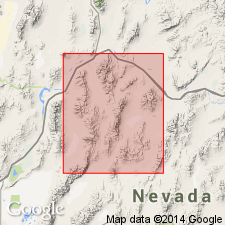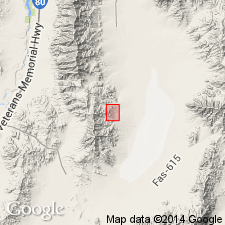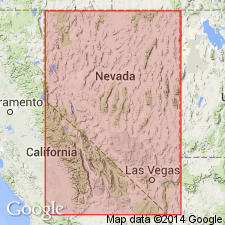
- Usage in publication:
-
- Congress Canyon Formation
- Modifications:
-
- Named
- Dominant lithology:
-
- Limestone
- AAPG geologic province:
-
- Great Basin province
Summary:
Unit is named Congress Canyon Formation of Star Peak Group for the unbedded cliff-like exposure of limestone at head of Congress Canyon (the type section). Formerly mapped as "lower member of Natchez Pass Formation" by Wallace and others (1969) [Geologic map of the Buffalo Mountain quadrangle, Pershing and Church Counties, Nevada: USGS Geologic Quadrangle Map GQ-821, scale 1:62,500]. Consists of coarse-grained, allochem-supported limestone interpreted to have been deposited between depositional sites of basinal rocks that form the upper member of the Prida Formation and more inner platform rocks included in the Augusta Mountain Formation. Thickness is 120 m (up to 300 m). Overlies unnamed upper member of Prida Formation; underlies Cane Springs Formation. [Interfingers with the Panther Canyon and Smelser Pass Members of the Augusta Mountain Formation]. Age is Middle Triassic (early through late Ladinian) and probably into Late Triassic (early Karnian), based on inferred stratigraphic deposition.
Type section: at the head of Congress Canyon, [in W/2 sec. 16, T. 30 N., R. 34 E.], in northern Humboldt Range [Pershing Co., NV]. Named from Congress Canyon.
Source: Modified from GNU records (USGS DDS-6; Menlo GNULEX).

- Usage in publication:
-
- Congress Canyon Formation*
- Modifications:
-
- Biostratigraphic dating
- AAPG geologic province:
-
- Great Basin province
Summary:
Congress Canyon Formation of Silberling and Nichols (1977) of the Star Peak Group adopted as defined by them. Overlies and equivalent in part to the upper member of the Prida Formation; unconformably underlies the Cane Spring Formation. Composed of coarse-grained limestone; platform-margin deposit found mostly in Humboldt Range; formerly mapped as the lower member, the Natchez Pass Formation (abandoned). Age is Middle (Ladinian) and Late (early Karnian) Triassic age.
Source: GNU records (USGS DDS-6; Menlo GNULEX).

- Usage in publication:
-
- Congress Canyon Formation
- Modifications:
-
- Not used
- AAPG geologic province:
-
- Great Basin province
Summary:
Congress Canyon Formation (Nichols and Silberling, 1977) is not recognized as a sedimentary unit. Structural, stratigraphic and petrographic evidence indicates that it is not in normal depositional sequence and may be structural unit formed by neomorphism of limestone during faulting. The Panther Canyon and Smelser Pass Members of the Augusta Mountain Formation are shown replacing the Congress Canyon Formation in the Humboldt Range area.
Source: GNU records (USGS DDS-6; Menlo GNULEX).
For more information, please contact Nancy Stamm, Geologic Names Committee Secretary.
Asterisk (*) indicates published by U.S. Geological Survey authors.
"No current usage" (†) implies that a name has been abandoned or has fallen into disuse. Former usage and, if known, replacement name given in parentheses ( ).
Slash (/) indicates name conflicts with nomenclatural guidelines (CSN, 1933; ACSN, 1961, 1970; NACSN, 1983, 2005, 2021). May be explained within brackets ([ ]).

